30 Christmas Plants And Flowers To Decorate Your Winter Season
Christmas plants, flowers, and shrubs brighten our world during the dark winter season.
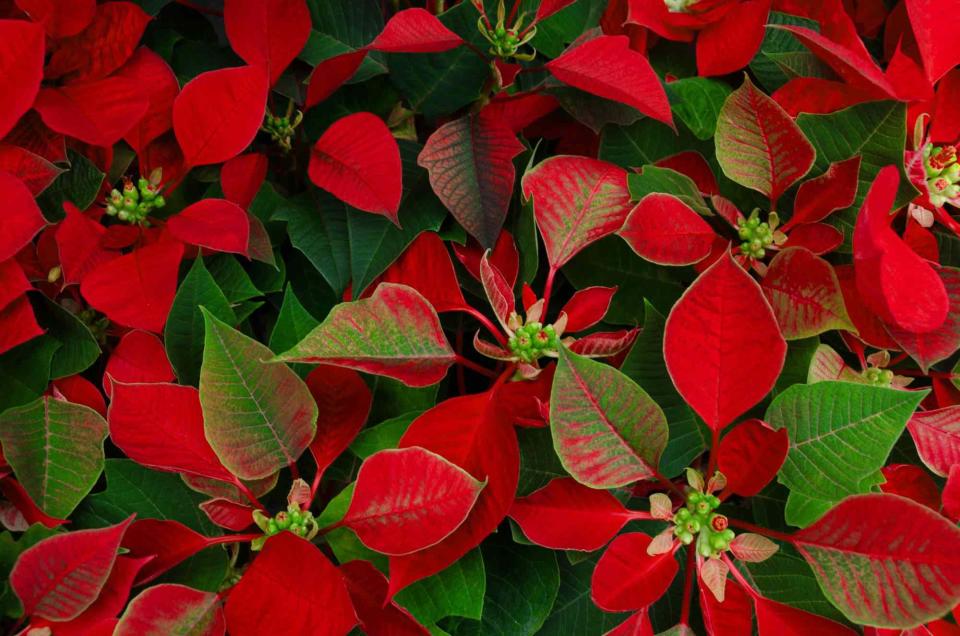
Although some plants go dormant during winter, we don't want our gardens to follow suit. We've selected a few of our favorite Christmas plants and flowers for the holiday season. Grow these selections for a garden plot that can withstand the cold weather—and look great.
These winter plants and flowers are evergreen shrubs and December bloomers, and some will even thrive when grown indoors during the cold months. From Amaryllis to paperwhites, they promise to add evergreen leaves, lush, needly branches, and a touch of scarlet to pots and plantings indoors and out. Scope out your local garden store for the prettiest poinsettia pots and find some Christmas flowers and plants that make lovely gifts.
Amaryllis
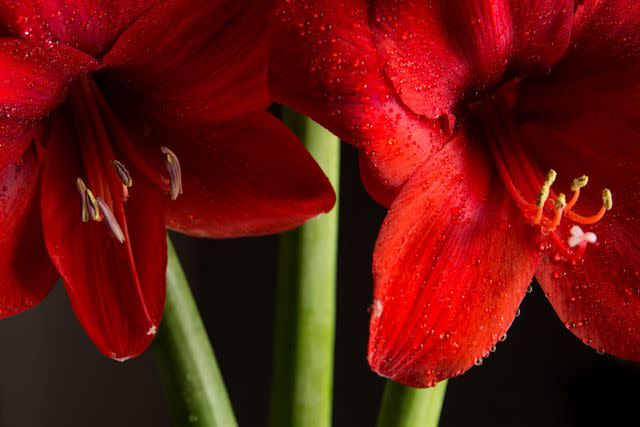
Amaryllis is a popular flowering plant for festive Christmas decor. It grows from a bulb and blooms about six weeks after planting. Some types, such as Amaryllis 'Ferrari,' are tended in greenhouses to encourage flowering in December—just in time for Christmas. Growing in October or November ensures Amaryllis will bear a cluster of vibrant red or white trumpet-shaped flowers come Christmas.
CARE: For a burst of holiday blooms, you'll either want to plant Amaryllis in the fall or buy bulbs already planted in pots. Once planted, allow it to soak up bright, direct sunlight, and provide regular water in well-drained soil.
American Mistletoe
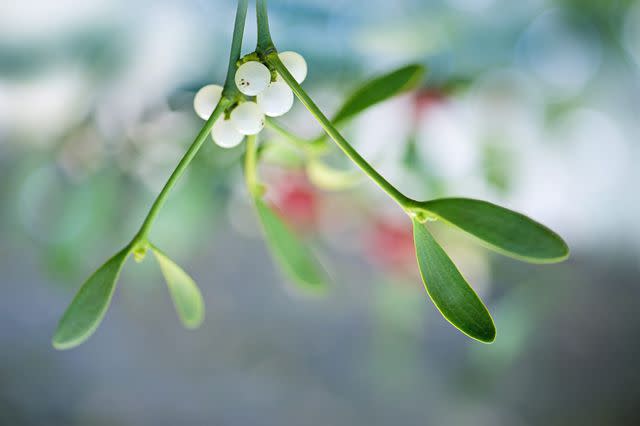
This festive plant comes with a warning. While no holiday scene would be complete without a drop of evergreen mistletoe, it's not commonly grown on purpose. American mistletoe (Phoradendron serotinum) is native from Florida to the mid-Atlantic and west to Texas. Its calling card is that it grows in a parasitic manner on the branches of host trees. Host trees are usually not harmed in this process, but it's nearly impossible to remove mistletoe once it has taken root in the bark of a hardwood.
CARE: Clipping mistletoe for an arrangement (or hanging from a ribbon in a doorway) won't cause permanent removal from the host tree. According to The Southern Living Garden Book, for lasting removal of mistletoe, "the infested branch must be removed at least one foot below the point of attachment. But since this process may disfigure the tree and reinfestation from nearby trees is likely, it's usually best to leave the tree alone."
Bodnant Viburnum
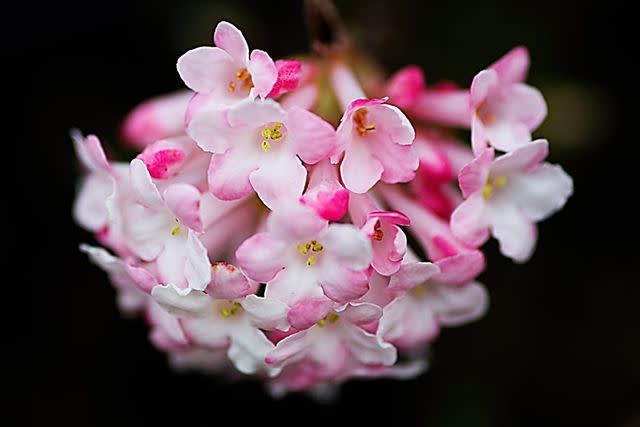
The deciduous plant Viburnum bodnantense grows to great heights—10 feet tall and 6 feet wide. The best-known selection is Viburnum bodnantense 'Dawn,' which produces subtle red fruit and blooms in winter. The blossoms that emerge in the cold months are fragrant pink flowers, fading from deep magenta to pale rose as they age. In fall, the color changes continue as Viburnum's green leaves turn a deep scarlet hue.
CARE: Viburnum species tolerate most soils, even those too heavy or lime-rich for other plants. They appreciate some shade in the hot Southern summers and require minimal pruning each year. They are also somewhat resistant to the damage often left by roaming deer, so they're a hardy enough choice for Southern gardens in the fall and winter.
Bosc Pear
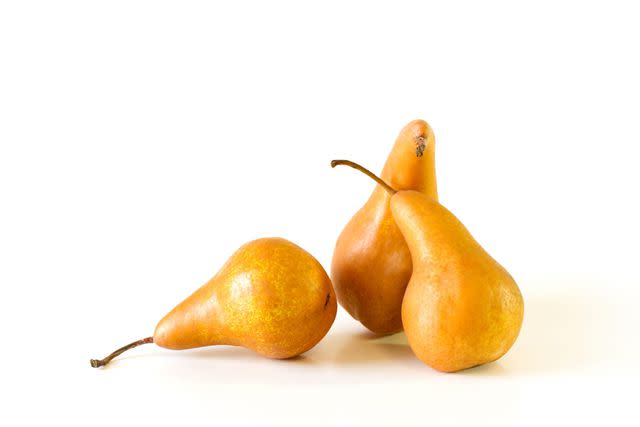
These deliciously crisp fruits ripen from late fall through winter. Once plucked from the tree, they develop a honeyed sweetness that's a perfect complement for winter dishes and desserts. Bosc pears make for excellent winter fruit trees that you'll look forward to harvesting yearly.
CARE: Plant Bosc pears in containers or gardens with full sun and ample water. Hardy in USDA zones 4–9, specific varieties are better suited for growing in containers. They can take several years to establish before bearing fruit.
Christmas Cactus
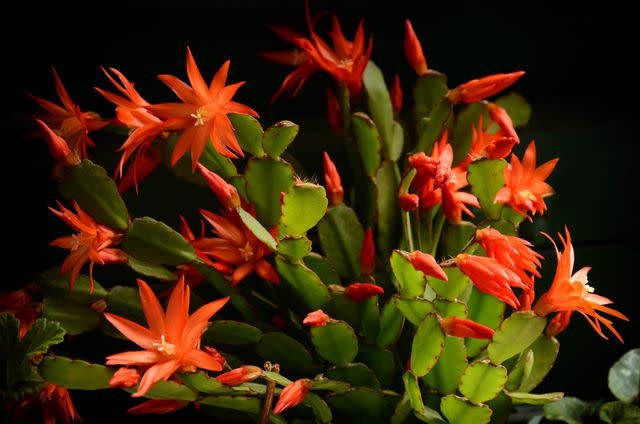
This festive cactus species blooms from late fall through winter, making it a colorful addition to Christmastime gardens. Schlumbergera x buckleyi (also known as S. bridgesii) has an eye-catching combination of bright green scalloped stems and long red flowers. S. truncata is another holiday-blooming cactus species with deep scarlet flowers. It's known as the Thanksgiving cactus because it blooms slightly earlier in the season.
CARE: The Christmas cactus grows best with regular watering in partial shade or bright indirect light. It also thrives in rich, porous soil. According to The Southern Living Garden Book, to encourage a December bloom, keep the plant in a cool-temperature environment (50-55 degrees) at night and ensure that it gets 12-14 hours of darkness each day during November.
Cyclamen
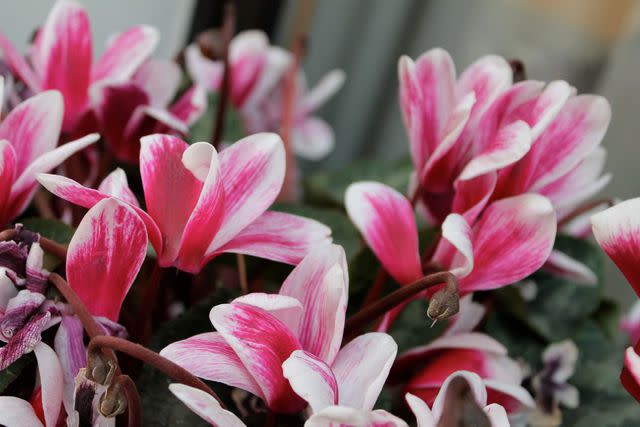
Cyclamen, a regional favorite, blooms during the winter in shades of white, pink, and red. It produces lovely Christmastime blooms and provides a subtle garden color. C. x atkinsii and C. coum develop crimson flowers in winter and have four to six-inch stems with deep green leaves. Some species bloom within a year, while others take many years to mature. Almost all species go dormant during the summer.
CARE: Cyclamen are good container plants and should be grown in full indirect sunlight or partial shade. They thrive in rich, well-drained soil that is neutral or slightly alkaline. Hardiness depends upon the species. Mix coarse sand and organic matter into the soil for an ideal environment before planting.
Fir Tree
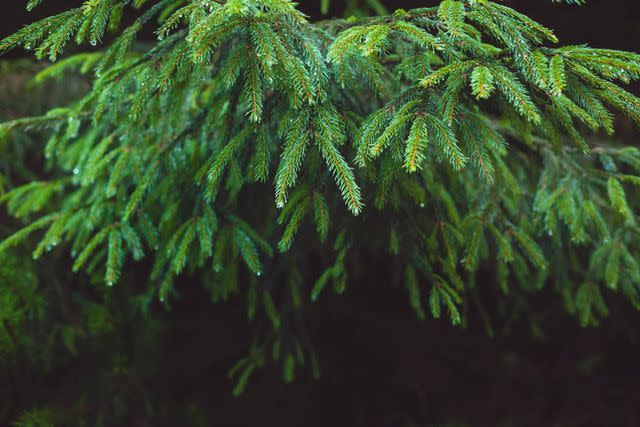
The mighty fir (aka Abies sp., aka the classic Christmas tree) comes in all heights and circumferences, so take stock of your living room, and buy one to fit. During the season, you can find them potted or pre-cut, or you can chop down one of your own at a nearby Christmas tree farm.
CARE: To place a tree in its stand, you'll need to first saw off one-quarter inch round from the bottom of the trunk. (This helps the tree better absorb water.) Next, place it in the stand, fill it with water, and keep it well watered throughout the season or until the needle shed signals the end of the holidays. If you have a potted tree, move it outdoors at the end of the holiday season and plant it in deep, well-drained soil. Planted firs won't always thrive in the South, as they require afternoon shade and a moist, cool environment for their root systems.
Glory Of The Snow
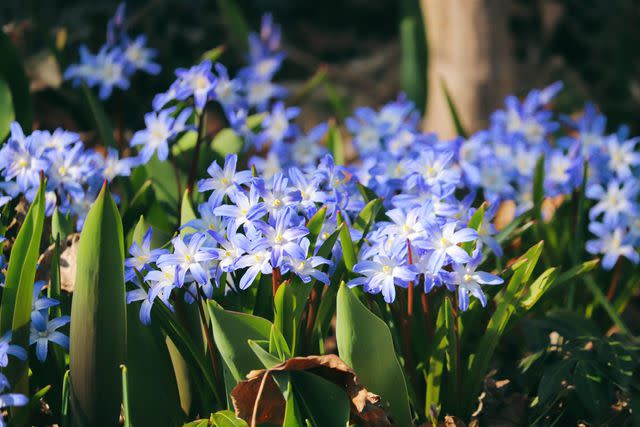
These charming flowers get their name from the time in which they bloom. They often bloom early enough to poke up out of the snow. Glory-of-the-snow (Chionodoxa forbesii) produces small, blue, and white star-shaped flowers.
CARE: These plants typically bloom in late winter or early spring in USDA zones 4–8 in full to partial sun. However, for an early potful of Glory-of-the-snow flowers, you can force Chionodxa to bloom indoors. To do this, plant them in pots in mid-October and follow the guidelines for moving plants to get them to bloom earlier. They'll need well-draining soil and rich potting mix when you plant them.
Ivy
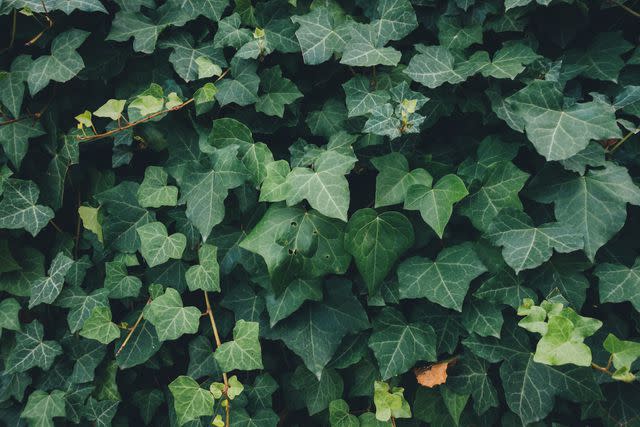
While ivy (Hedera sp.) tends to invade (one reason some gardeners avoid it altogether), it's also a beautiful, deep green addition to holiday scenes—hence the Christmas carol "The Holly and the Ivy." This evergreen climbing vine can spread horizontally over the ground or vertically up walls. It's also lovely, dangling from hanging baskets or trellises and curling delicately in pots. English ivy (H. helix) is a less vigorous grower than other Hedera species, but it's a beautiful Christmastime planting with its telltale lobed green leaves.
CARE: Plant ivy in spring or fall, and it is most reliable when grown from a pot of seed rather than from a cutting. Ivy likes soil full of organic matter and should be fed with nitrogen-rich fertilizer in spring and summer to encourage growth.
Juniper
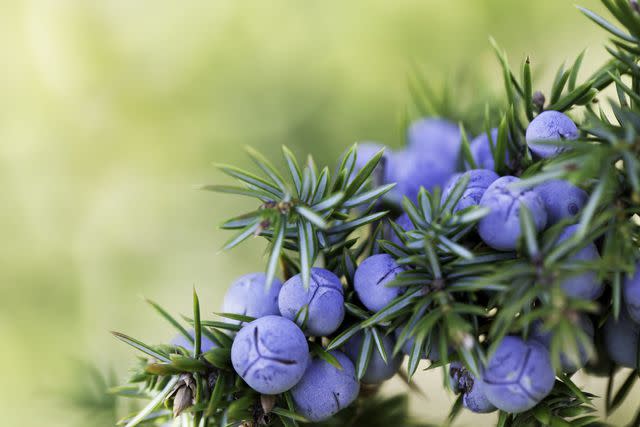
This beautiful evergreen shrub has attractive foliage made of dark green needles born profusely on its stems. It also has pretty blue-hued berries in winter. They grow as shrubs, trees, or in columnar forms. 'Bar Harbor' has feathery, blue-gray foliage that shifts to purple in the winter months.
CARE: Most grow best in drier, chalkier soils and can be very fast growing under the right conditions. Plant juniper in gardens or large containers, but give them plenty of space to grow. Because of this, they can also work as a ground cover.
Lenten Rose
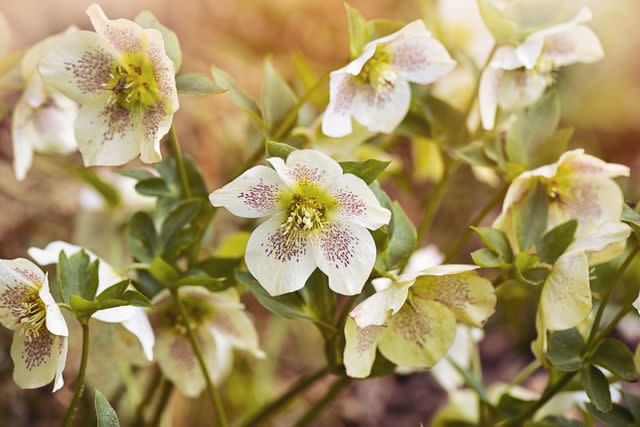
Lenten rose, or Helleborus, is a good choice for subtle color in the winter and early spring in much of the South. Hellebores bloom in a drooping cup or bell-shaped flowers across the color spectrum—white, green, pink, red, or purple flowers emerge during the cool season in USDA zones 4–9 depending on the species and selection. The blossoms also last and maintain their form but fade to green as the blooming period ends.
CARE: Lenten rose is a long-lived plant in the garden. Most hellebores thrive in well-drained, moderately moist soil in light shade. Once planted, this semi-evergreen plant likes to be left alone (and it often is—hellebores are deer- and rodent-resistant).
Mahonia
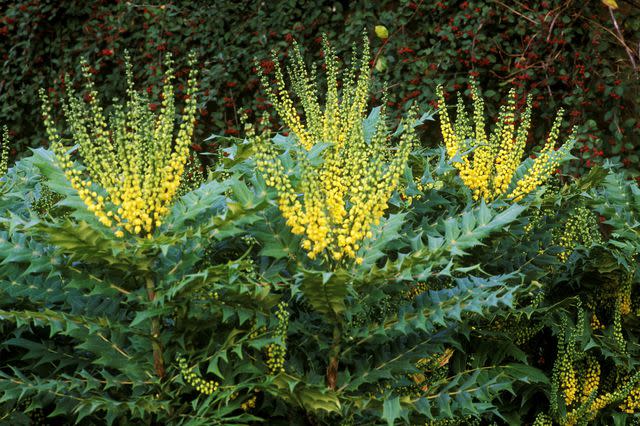
Mahonia x media is a species of evergreen shrub that looks like holly but is related to barberry (Berberis). The plant's prickly leaves are a deep green backdrop for the clusters of impressive yellow flowers blooming in winter. Mahonia x media 'Winter Sun' flowers are earlier blooms than other Mahonia species and selections. It produces fragrant blooms that appear around Christmastime and accompany the berry-shaped fruit and the plant's signature dramatic foliage.
CARE: Mahonia is considered invasive in some Southern states. This is a low-maintenance planting, requiring well-draining soil and only the occasional prune. It is both pest- and deer-resistant, and you can expect Mahonia x media 'Winter Sun' to reach 4 to 5 feet tall and wide.
Ornamental Cabbage And Kale
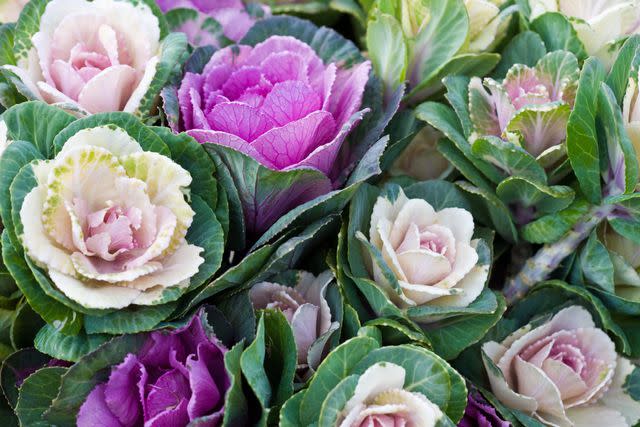
Ornamental cabbages and kales are popular additions to winter containers because of their flashy colors and textures. They are hardy throughout the South and can withstand below-freezing winter temperatures. Also known as flowering cabbages and kales, these plants are beautiful additions to cold-season gardens.
CARE: Ornamental cabbages and kales grow best in full sun or partial shade and need rich, well-drained soil. Plant them in containers (one per small pot, several to large containers) or the garden (15-18 inches apart in beds), and give them regular water.
Pansy
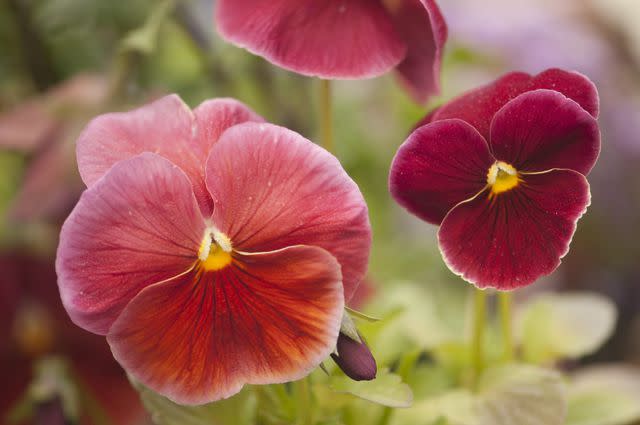
Viola x wittrockiana, also known as pansy, is a perennial in the Violaceae family (alongside violas and violets). Despite its hardiness in the South, it's often grown as a cool-season annual as it doesn't like heat. It has shiny green leaves and flowers in white, blue, red, and yellow hues. Sprite Mix is a pretty and reliable choice if you're looking for winter ground cover. Select 'Padparadja' for reddish petals and 'Springtime Black' for lush dark blooms. Viola cornuta is also grown as a cool-season annual, and its flowers come in varied shades too.
CARE:Choose pansies for mass plantings in garden borders. It thrives in mild winters when planted in rich, moist soil. It would help if you also kept your pansy plantings well-watered once they're in the ground, and when selecting a spot to plant, keep in mind that they grow best in an area with partial to full shade.
Paperwhites
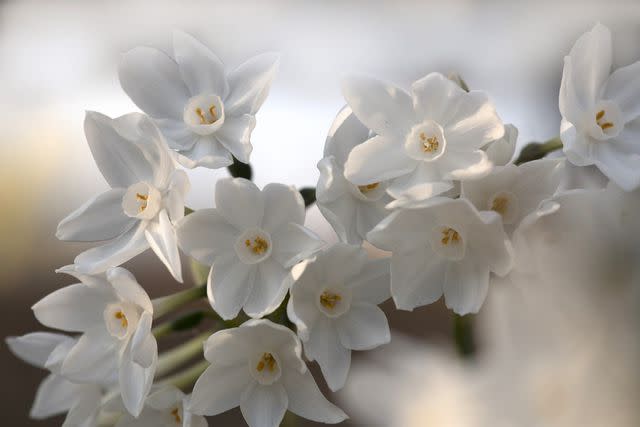
Paperwhite narcissus (Narcissus papyraceus) is a perennial that grows from a bulb and can flower indoors during winter. It requires little soil. Once planted, expect blooms in four to six weeks. When it flowers, the paperwhite produces delicate, fragrant white flowers appearing in bunches on tall green stems.
CARE: Paperwhite narcissus is a hardy, albeit fleeting, blooming bulb and often flowers at Christmastime. To encourage blooming, keep the bulbs in darkness until you're ready to plant them, and once planted, water them regularly in well-drained soil. It would help if you kept them in a cool environment away from direct sunlight. Once the blooms appear, they'll likely begin to droop. When this happens, you'll need to stake the stems for support.
Poinsettia
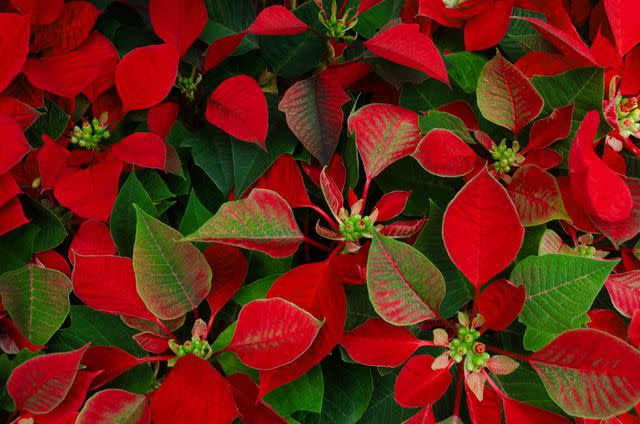
The holiday season's most festive (and ubiquitous) flower is the scarlet-blooming poinsettia (Euphorbia pulcherrima). It's an evergreen, semi-evergreen, or deciduous shrub that can thrive indoors or outdoors. Its showy, petal-like bracts are well-known at Christmastime, as it is omnipresent in the single red form. Other forms are double-bracted, white, yellow, and pink, but you're most likely to encounter scarlet leaves at your local garden stores.
CARE: Avoid overwatering poinsettia plants. Take care to water moderately only when the soil becomes dry. Poinsettias require little in the way of care and will grow tall and leggy before you know it. If you take cuttings, do so in late summer and encourage blooming by ensuring new plants get up to 14 hours of darkness per day beginning in October.
Primrose
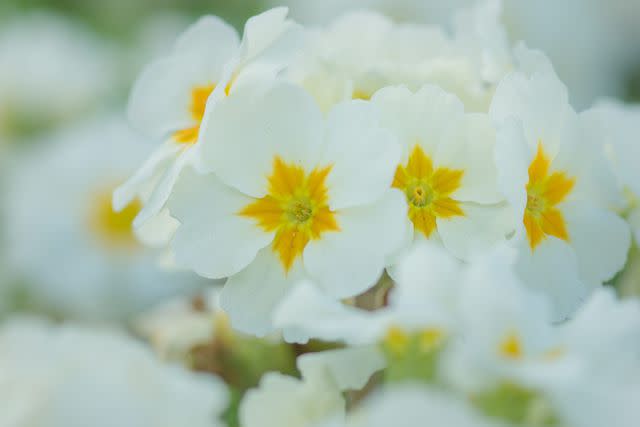
While many species of primrose (Primula sp.) bloom in spring and early summer, several types bloom in winter. P. x polyantha, often called polyanthus primrose or English primrose blooms from winter to spring and bears bright, showy, five-petaled flowers in thick, romantic clusters. The hues of these flowers vary among the species and selections. At the base of the English primrose plant are clumps of foliage resembling the leaves of romaine lettuce.
CARE: These plants thrive in pots and when planted en masse. Primrose requires a cool, humid climate in USDA zones 4–8 and soil that's both moist and rich. According to The Southern Living Garden Book, many species can grow as perennials, but people treat them as cold-season annuals.
Rosemary
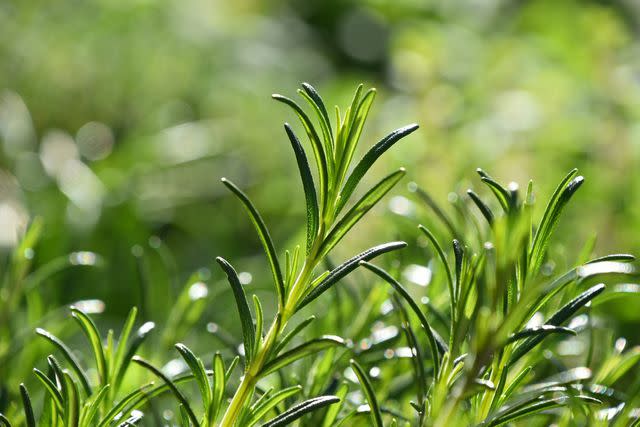
An herb you can always count on at Christmastime is rosemary, the stalks of which resemble miniature evergreen trees. Use their fragrant leaves to flavor dishes and desserts, and they're easy to grow indoors for quick kitchen access.
CARE: You can grow rosemary indoors or out, where it is hardy in USDA zones 7 and warmer. Indoors, grow rosemary in pots on a sunny windowsill. They can overwinter indoors, or you can treat them as annuals. They require regular water and plenty of bright light. Outdoors, rosemary requires full sun and well-drained soil.
Snowdrops
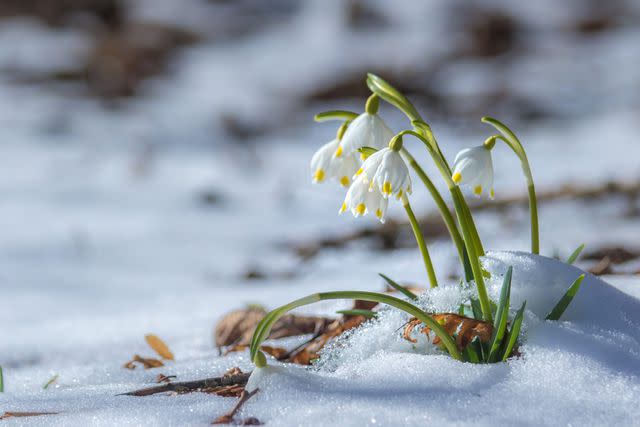
Snowdrops (Galanthus species) bloom in late winter or early spring. They're charming when planted en masse and send up small white bell-like blooms during chilly weather (they won't do well south of USDA zone 8). Among the first bulbs to bloom, they add a cheer to the garden and can also bloom a bit earlier.
CARE: Plant snowdrops in a sunny or partially shady spot during the fall. They thrive in moist, well-drained soil and need regular watering. Plant them three to five inches deep and two to three inches apart. Snowdrops can also grow indoors. To do this, plant the bulbs in pots and keep them in darkness in a very cool spot for 10 to 12 weeks. After the buds appear, move them to a cool, bright area to encourage blooming.
Valencia Orange
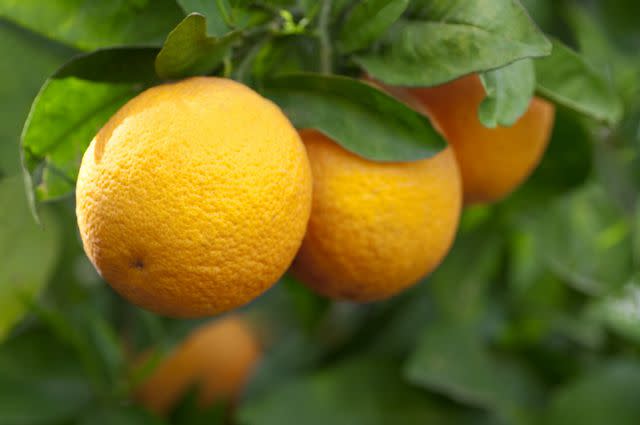
Valencia orange (Citrus x sinensis 'Valencia') is a sweet orange cultivar known widely as the ideal orange for juicing. If you're looking for an earlier ripening, 'Delta' and 'Midknight' are good alternatives and produce entirely seedless fruit. These types are moderately resistant to cold in the South (hardy in USDA zones 8–11). For more cold-hardy citrus, try planting kumquats or satsuma mandarins.
CARE: Winter citrus is a dose of sunshine in the colder months. In addition to fruit, citrus plants offer shiny, year-round foliage and bear small, fragrant blossoms. When planted, citrus requires regular water and full sun to ensure it will thrive, hence its profusion in sunny states such as Florida and California.
Winterberry Holly
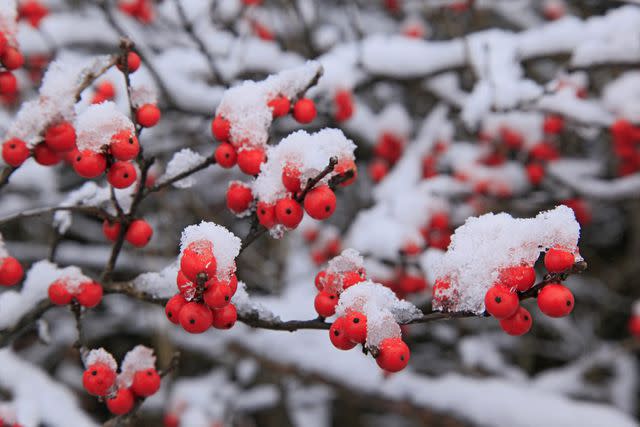
Female varieties of this jolly holly (Ilex verticillata) produce bountiful bright red berries in fall and winter in USDA zones 3–9. Winterberry may drops its leaves in winter, but its berries positively glow with Christmas cheer. Winterberry is native to the Eastern U.S. and is an easy-care plant that can grow to 15 feet tall and wide.
CARE: While it's a low-maintenance winter plant, you can give winterberry holly ideal growing conditions by planting it in full sun or partial shade. It's deer resistant but loved by birds and butterflies. Plant winterberry in moist, acid, organic soils, and it should grow well.
Winter Honeysuckle
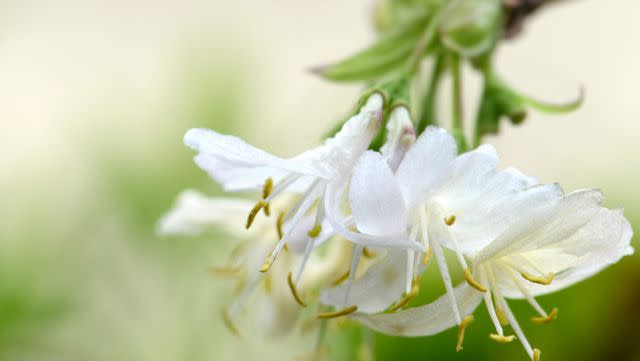
Honeysuckle occurs in evergreen, semi-evergreen, or deciduous shrubs and vines. This particular plant, also known as Lonicera fragrantissima or January jasmine, is a highly fragrant semi-evergreen shrub with long, oval leaves in shades of dark green. Winter honeysuckle flowers throughout the winter and produce tiny cream-colored blooms that carry a sweet fragrance. The flowers accompany small, red fruit that resembles other, more familiar berry forms. Check to see if winter honeysuckle is invasive in your state before planting.
CARE: Winter honeysuckle is a good choice for a compact clipped hedge. It's an attractive outdoor planting, and once buds emerge in winter, branches can be clipped and brought indoors to bloom. Doing this will fill your home with a telltale delicately sweet honeysuckle scent.
Yaupon Holly
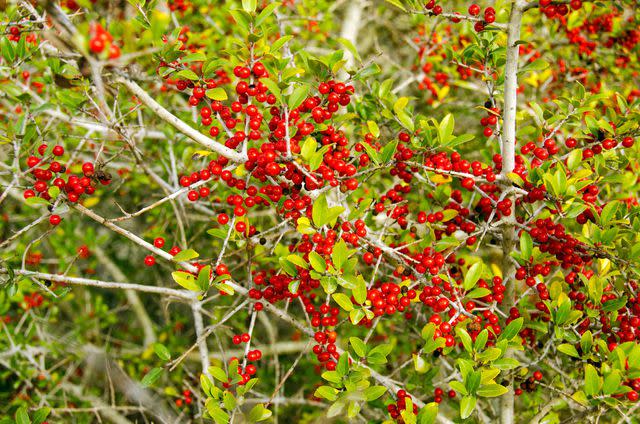
Yaupon holly, also known as Ilex vomitoria, is native to the American South, and it's known for its bright sprays of red berries that appear in the winter months. It's a beautiful ornamental accent in winter gardens or holiday decorations.
CARE:This evergreen holly grows as an upright shrub or multi-trunked tree to about 20 feet tall (look for dwarf varieties if you want a compact shrub). It is hardy in USDA zones 7–9 and can be grown in nearly any type of soil in full or partial sun. It also is popular as a screen or trimmed into hedges. This plant is resistant to deer and can tolerate difficult conditions, including prolonged sea spray.
'Yuletide' Camellia
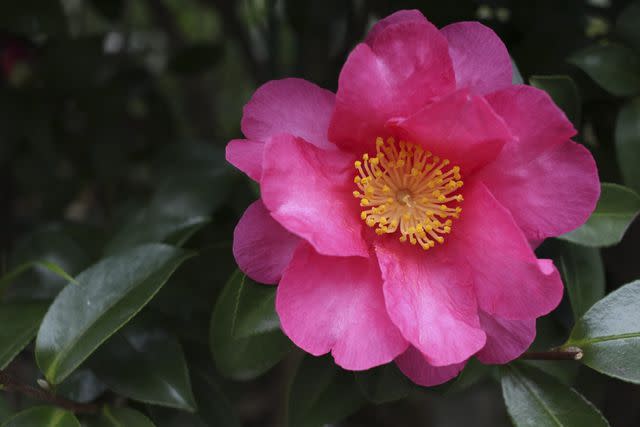
Camellia sasanqua 'Yuletide' is a winter-blooming flowering shrub. 'Yuletide' camellia's blooming season begins in fall and lasts through the winter, making it a strong contender for garden color at Christmastime. It bears bright red, single blooms on a small, densely foliated plant. While most thriving camellias expect to grow 8 to 10 feet tall, this is a compact selection and will grow 4 to 5 feet tall and 6 to 8 feet wide.
CARE: This particular camellia is a drought-tolerant, hardy perennial plant that requires little garden maintenance once established. It's evergreen and thrives in the mild winters of the South. When planting, ensure it's in a spot where it will receive partial to full sun and begin with moderate to regular watering.
Winter Aconite
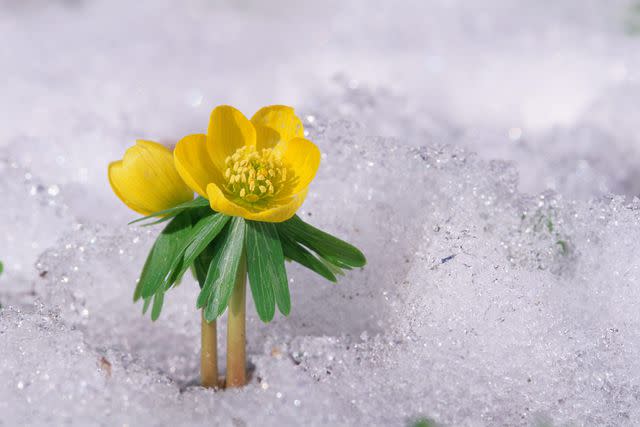
These tiny flowers are native to Europe and Asia. Winter aconite (Eranthis hyemalis) has bright yellow blooms that resemble buttercups, can reach a few inches high, and sometimes pop up from the snow-covered ground. They tend to bloom in late winter or early spring.
CARE: For winter blooms, plant the tubers in late summer. Place them in a spot with full sun or partial shade. Plant them at least three inches deep and four inches apart in moist, porous soil. They also grow best with regular water.
Crocus
In the Upper and Middle South, these bulbs naturalize in the garden. Translucent, tissue-paper blooms perch above the still-cold earth and stretch for warmth on sunny days. These early risers also take to containers, so you will find them coaxed into bloom in garden shops. Nurseries produce blooming containers for immediate enjoyment.
CARE: Crocuses do best in a spot that gets full sun (6+ hours of direct sunlight), but will grow in partial sun as well. Choose a planting site where there is well-draining soil; the corms will rot in soggy, compacted ground. Before planting, work in organic matter such as compost to a depth of at least 10 inches.
Primrose
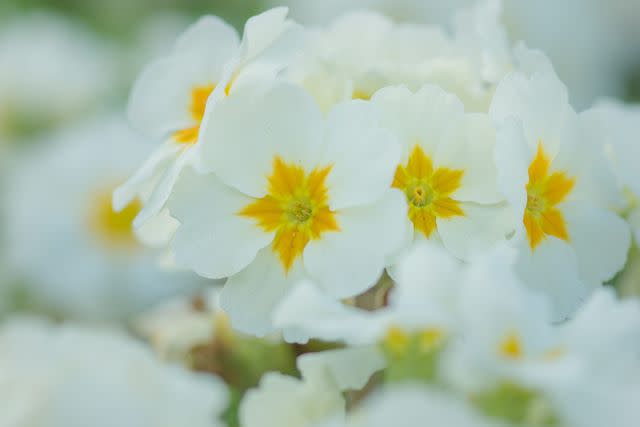
The Upper South enjoys the happy primrose as a perennial under trees and shrubs. The rest of us appreciate them as seasonal potted plants. Few plants beat the primrose for winter color, and they are extremely cold-hardy. Pick up a few in February and plant them in the ground or in containers where they do well outdoors.
CARE: Primroses prefer cool weather and damp soil. If you choose to keep them indoors, find a chilly windowsill, and water the soil as it begins to dry. Outdoors, they snuggle into containers and thrive, provided they don't suffer a hard freeze. Again, moisture is key. They thrive in partial shade and need regular watering. They prefer the soil to be well-draining, and slightly more acidic. Use half-strength fertilizer when regularly feeding these pretty florals.
Winter Pansies
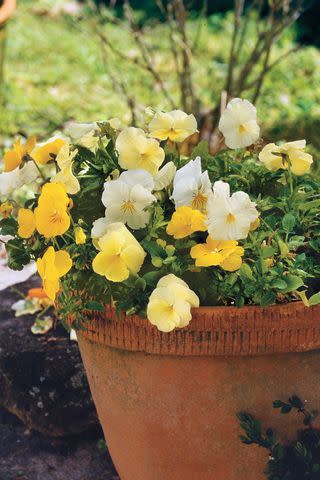
Just because the cold comes around doesn't mean you have to give up color in your garden. Winter pansies (Viola hiemalis) are perfect for wintertime flowerbeds. Unlike your typical pansies, winter pansies are a unique, more cold-hardy species, making them perfect for planting in the colder months.
CARE: While winter pansies are very tolerant of the cold, they grow the best in sunlight. When planting your pansies, consider their location. Plant them where they are facing the sun, and give them at least four hours of sunlight per day. Winter pansies will bloom for five to eight months if cared for properly, which means you get a lot of color for a large portion of the year. Plus, winter pansies can return for three years or more.
Calendula
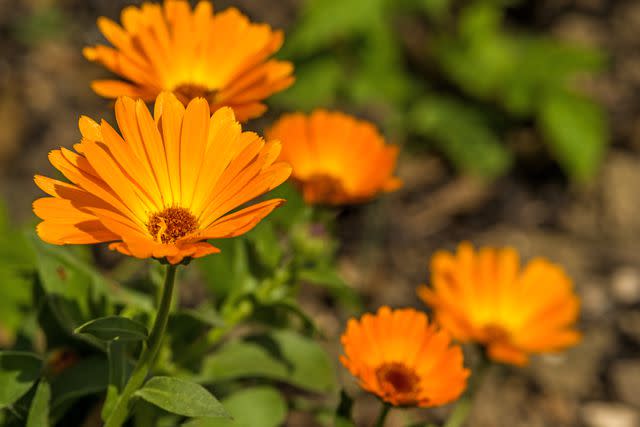
Getty Images
Often called pot marigold, calendula thrives under cool temperatures and can be grown as a winter annual in many areas of the south. In warmer areas, seeds can be sown in late summer or early fall for vibrant blooms during the colder months of the year. In cooler areas, calendula is grown in the shoulder seasons, however a simple frost blanket on cold nights can extend a fall planting well into the winter months.
CARE: This vibrant herb is readily adaptable to almost any garden in the United States. It tolerates temperatures down to 26°F but can be heat sensitive in temperatures above 85°F. The plants don’t usually die in extreme cold or heat, but they may stop blooming. Hard freezes will kill calendula plants and leave behind their seeds for next year’s self-sown patch.
Winter Jasmine
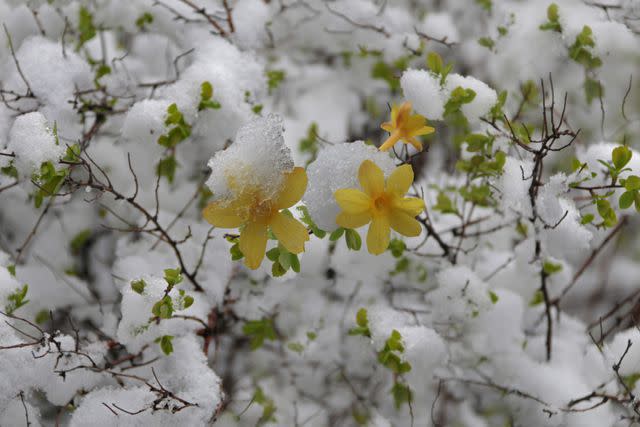
This winter hardy shrub thrives best in USDA Zones 6-10 and blooms mid-winter or early spring. Winter jasmine is fast-growing and spreads, making it a good plant to train to grow over a trellis or use as ground cover. These alluring, deciduous shrubs attract butterflies, are pet-friendly, and are relatively low-maintenance as far as care is concerned.
CARE: For best results, plant winter jasmine in an area with well-drained soil that receives full sun—even in the winter. Full or partial sunlight is needed, so plant winter jasmine in an area that receives two to six (or more) hours of direct sunlight.
For more Southern Living news, make sure to sign up for our newsletter!
Read the original article on Southern Living.

